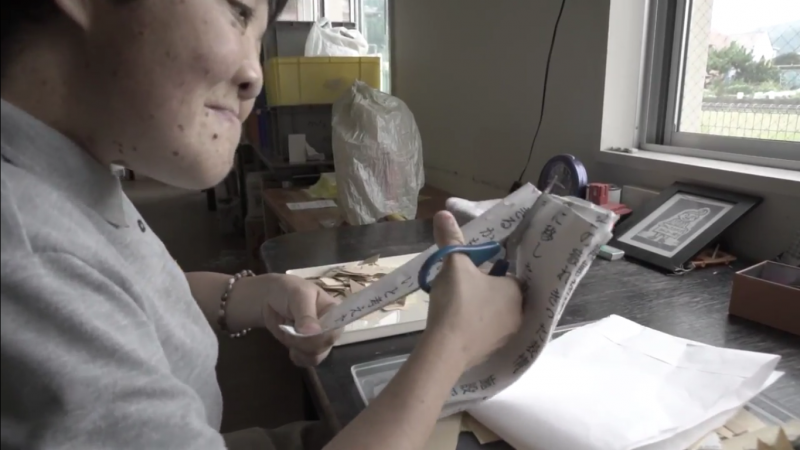
Sachiko, a papermaker and a resident of a care home for people with disabilities, cuts up a letter written by the alleged perpetrator of Japan's worst mass-murder since World War II in order to make paper. Screencap from YouTube.
July 26 marks one years since the murder of 19 mentally disabled people in a care home in Sagamihara, about fifty kilometers west of Tokyo. While the suspect in the case, Uematsu Satoshi, has admitted to killing 19 residents of the care home, and wounding 26 others in a premeditated knife attack conducted with methodical precision, the case has still not been brought to trial.
The Sagamihara massacre and the national dialogue—or lack of it—highlights how disabled people are often ignored in Japanese society. Local police have also implemented a publication ban on the names of the victims, all of whom were disabled, making it harder to discuss the murders at the Sagamihara care home.
Uematsu Satoshi, the suspect in the case who admitted to the murders, was a former employee of the care home. The care home came to understand he was a threat to residents, and fired him prior to the attack. Uematsu had actually stated his intention to kill residents of the home in a letter sent to a local politician. In the letter, which can be read in full here, Uetmatsu carefully outlined his plan to kill residents of the care home, and stated “the disabled can only create misery” and that all should be eliminated. The letter was ignored.
As a response to Uematsu's letter, and to mark the one-year anniversary of the Sagamihara murders, L'Arche, an international non-profit devoted to improving the lives of people living with intellectual disabilities, released #As I Am: Nineteen Paper Cranes, a short web video:
The video was produced by L'Arche Japan, which runs a group home for people with intellectual disabilities in Shizuoka Prefecture, which neighbors Kanagawa Prefecture where the Sagamihara murders occurred. The short video features a woman Sachiko, a resident of the home who makes traditional Japanese paper.
Following the shock of learning about the murders on Sagamihara on July 26, 2016, and what motivated the alleged killer Uematsu Satoshi, Sachiko and her fellow care home residents responded by creating 19 paper cranes out of Japanese paper—one paper crane for each person killed in the care home in Sagamihara. Sachiko made the cranes from a paper facsimile of the letter Uetmatsu had sent to a local politician, where he had argued about the uselessness of disabled people.
The video ends with the words, “Imagine the world differently,” and also asks viewers to question their own assumptions about people who live with disabilities.
The video is part of the #As I Am web series created by L'Arche intended to highlight the lives of people living with intellectual disabilities around the world.
In a YouTube comment, a representative from L'Arche states, ” We created this Web Series because we believe that people with intellectual disabilities live in the shadows of a persistent view–present in all cultures–that they are the undesirables. This is one of our world’s significant injustices. It is one we can change.”







3 comments
I am a citizen of the United States who believes that we all have a responsibility for others in all of the nations of the world. Watching “Imagining The World Differently” made a huge impression on me because of a personal time in my life when I knew my good friend, Frieda. She was a person who had cerebral palsy. Even with crippling in her hands and body, and difficulty speaking, she produced a lot of hand made knitted and crocheted items which are beautiful. I wear the red sweater I bought from her often even though the pockets are backward. Frieda and I enjoyed bright colors and other things that I like too and she and I discussed women’s rights together. I always went to visit her after we moved to different cities; when she died, I called the home and they wouldn’t give me any information. Luckily, I had another friend’s phone number, and later, five of us who were her friends got together for a meal and to remember Frieda as our good friend. I have counted Frieda as one of my best friends in my life.
Hi there, thanks for your comments, and thanks for sharing the story (I am the author of this piece).
thank you for your response, I watch this site all of the time and find topics that are not reported in other places. I appreciate that very much.